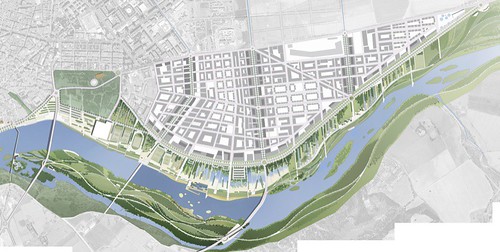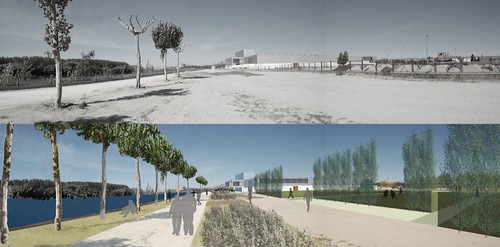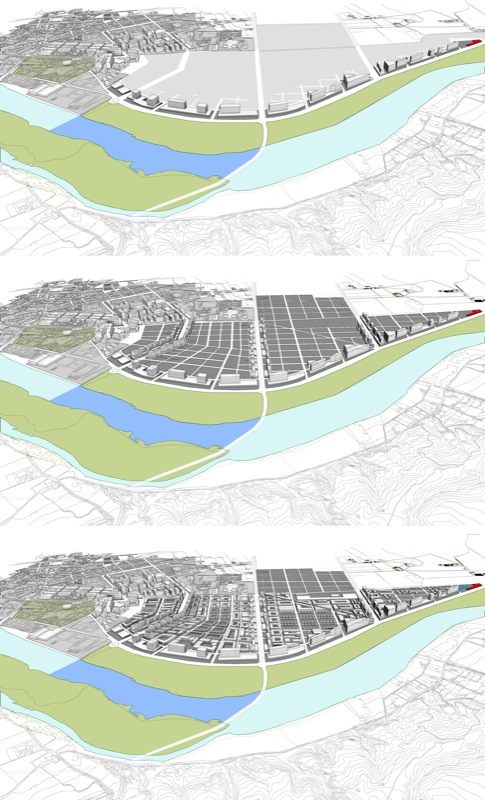
Sep '06 - Dec '09
I, like many people, have often complained about the divide between the academic and professional world, as in studios we are asked to do things that very often have little to do with the pressures of the 'real world'. This is why I am VERY happy to have had a Carl Steinitz signature research studio for my 13th semester in design school(s).
Over the past 25 years Carl has developed a studio that unmercifully focuses on a real-world landscape and urban problem at a large scale. He then brings people from all the departments and as cohesive group they work on the problem at many scales. The end result is not any individual's project, but the entire studio's work and it is presented in just that manner with collective ownership of the research product. In this way the studio successfully recreates the environment of many design firms.
Carl is now semi-retired, or something like that, and he is teaching in conjunction with Christian Werthmann who, to me, seems interested in keeping the system alive while increasing the role of the design product.
This is the context for the 'Reviving the Tajo River' project in Spain. We are looking at middle Tajo basin which includes sites and cities in the provinces of Madrid and Castilla la Mancha. The smaller sites we are looking at as our 'context' are: Madrid's Jarama river, Aranjuez, Toledo, and Talavera de la Reina.
Although I participated in design at larger scales and at different times in other smaller sites, I ended up focusing most of my energy on the Talavera de la Reina site, in a group with Ji Hyun Yoo (MLA II) and Alexis Peterson (MUP). The main problem here is that for a city that has an ancient temple to the water goddess it has forgotten about its waterfront. We are proposing to connect the local landscape (mountains in the north, the Tajo river, and a escarpment in the south) through a series of uncovered arroyos in major streets.
We are also proposing to buck the trend of U.S.-style low-density housing for a higher density development in front of the river, using the arroyos and river as the main urban features. This city, in eastern Talavera, would collect its rain water and treat its sewer through a system of tertiary treatment wetlands, reducing the need of fresh water by more than 50%.
Finally, we are also proposing a continuous waterfront park. This park starts with the development's wetlands and connects through an existing recreation facility and an unused island in the Tajo, then moving to the historic city (as old as the celts and romans), and ending in the western Talavera's University. In order to bring life back to the river, important aspect in any restoration effort, we are also creating a new swimming beach in front of the island and recreation areas, this assumes that projects upstream have cleaned the river, or if that fails, that the wetlands could provide clean water.
The final presentation is on Wednesday, to an invited delegation from Spain, and I will blog and post pics of the proceedings along with some of the other projects. These are SOME of the many products we (the Talavera team) produced to show in detail everything I just skimped over:
Plan of proposed waterfront and development
Before and After of wetlands and east Talavera development
Before and After of recreation area
Elements of east Talavera
From Top: 1- Water Front Mid Density, 2- High Density Arroyo Streets, 3- Fill in from Arroyo Streets 
Pics from the final review. Next up for this studio: Presentation in Madrid and Toledo, mid-January, then a possible publicaton.
Overall I have enjoyed my foray outside of architecture, and I am specially glad I took a studio that is as diverse as this one, but I am ready to design me a building...



7 Comments
Q...
This is exactly the kind of work i dream about..
Landscape urbanism and re-invention on this scale is why i would even consider going back to school..
I just wish i was sure i could do it....
q- looks like hargreaves was your main landscape inspiration. i like the street grid that fans out.
so now you can connect your buildings to the bigger picture with your buildings.
enjoy the final review and your well deserved winter break!
nam, you could certainly do it, but it would change you.
q, this sounds like a very engaging studio. i would love to work at that scale!
...keeping the system alive while increasing the role of the design product.
how exactly?
well, in the past it seems like the end product was maps, planning studies, schematic sections, etc... Now we are actually designing landscapes, proposing urban forms, etc... I was supposed to design a water treatment plant as the token architectural scale, but never had the time to do it.
@ AP
Change me, i should hope so.
Unless you mean take/kill my current fantasy-based enthusiasm.
As you said the scale is fascinating.
Q,
I like what you said above about designing landscapes and urban "forms"
I wonder could such be done at any scale? At what point does landform become land art?
Is it based in the science applied or not? rigor and, process and research?
Nice! It reminds of what UPenn just did for the Delaware River-front.
nam, I am not entirely sure about the question, but it sounds really interesting.
It is based on research, but i would be hesitant to call it a science, as design is hard to describe in such a way. We are making proposals after looking at all the facts, looking at what happens if current trends continue (U.S. styled sprawl + the tajo as a sewer), and how we can use planning and design solutions (at all scales) to make an alternative future by 2030.
Block this user
Are you sure you want to block this user and hide all related comments throughout the site?
Archinect
This is your first comment on Archinect. Your comment will be visible once approved.